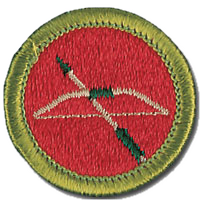Archery


Resources
- Archery Merit Badge Pamphlet
- Archery Merit Badge Class Preparation Page
- Archery Merit Badge Workbook
- Scoutmaster Bucky's Merit Badge Advancement Quick Reference
- Scoutmaster Bucky's Acknowledgement Form
Archery Requirements
Current Scouts BSA requirements
as of December 16, 2025
as of December 16, 2025
1.
Do the following:
a.
Explain what a projectile is, and why any device that shoots a
projectile at high speed must be handled with care and respect, and
used only in approved locations.
b.
Explain the five range safety rules.
c.
Explain the four whistle commands used on the range.
d.
Explain how to safely remove arrows from the target and return them to
your quiver.
e.
Tell your counselor about your local and state laws for owning and
using archery equipment.
2.
Do the following:
a.
Name and point to the parts of an arrow.
b.
Describe three or more different types of arrows.
c.
Name the four principal materials for making arrow shafts.
d.
Do ONE of the following:
1.
Make a complete arrow from a bare shaft using appropriate equipment
available to you.
2.
To demonstrate arrow repair, inspect the shafts and prepare and
replace at least three vanes, one point, and one nock. You may use
as many arrows as necessary to accomplish this. The repairs can be
done on wood, fiberglass, or aluminum arrows.
e.
Explain how to properly care for and store arrows.
3.
Do the following:
a.
Explain the proper use, care, and storage of, as well as the reasons
for using tabs, arm guards, shooting gloves, and quivers.
b.
Explain the following terms: draw length, draw weight, mechanical
release, barebow.
4.
Explain the following:
a.
The difference between an end and a round
b.
The differences among field, target, and 3-D archery
c.
How the five-color World Archery Federation target is scored
d.
How the National Field Archery Association (NFAA) black-and-white field
targets and blue indoor targets are scored.
5.
Working under the supervision of a certified USA Archery Level 1 Instructor
or a certified long-term camp staff member (i.e., a National Camping School
[NCS] Range Activities Director; or a Rangemaster over age 18 who is
trained by a NCS Range Activities Director or by a USA Archery Level 1
Instructor), do ONE of the following Options:
Option A—Recurve Bow or Longbow. Do the following:
a.
Name and point to the parts of the recurve or longbow you are
shooting.
b.
Explain how to properly care for and store recurve bows and
longbows.
c.
Demonstrate and explain USA Archery's eleven "Steps of Shooting"
for the bow you are shooting.
d.
Demonstrate the proper way to string a recurve bow or longbow.
e.
Using a bow square, locate and mark with dental floss, crimp-on, or
other method, the nocking point on the bowstring of the bow you are
using.
f.
Do ONE of the following:
1.
Using a recurve bow or longbow and arrows with a finger
release, shoot a single round of ONE of the following:
a.
An NFAA field round of 14 targets and make a score of 60
points
b.
A Scouting America field round of 14 targets and make a score
of 80 points
c.
A World Archery/USA Archery indoor round and make a score
of 80 points (indoor rounds may be shot outdoors if this is
more convenient)
d.
An NFAA indoor round and make a score of 50 points (indoor
rounds may be shot outdoors if this is more convenient).
2.
Shooting 30 arrows in five-arrow ends at an 80-centimeter
(32-inch) five-color target at 10 yards and using the 10
scoring regions, make a score of 150 points.
Option B—Compound Bow. Do the following:
a.
Name and point to the parts of the compound bow you are shooting.
b.
Explain how to properly care for and store compound bows.
c.
Demonstrate and explain USA Archery's eleven "Steps of Shooting" for
the bow you are shooting.
d.
Explain why it is necessary to have the string or cable on a compound
bow replaced at an archery shop.
e.
Locate and mark with dental floss, crimp-on, or other method, the
nocking point on the bowstring of the bow you are using.
f.
Do ONE of the following:
1.
Using a compound bow and arrows with a finger release, shoot a
single round of ONE of the following:
a.
An NFAA field round of 14 targets and make a score of 70 points
b.
A Scouting America field round of 14 targets and make a score of
90 points
c.
A World Archery/USA Archery indoor round and make a score of 90
points (indoor rounds may be shot outdoors if this is more
convenient)
d.
An NFAA indoor round and make a score of 60 points (indoor rounds
may be shot outdoors if this is more convenient)
2.
Shooting at an 80-centimeter (32-inch) five-color target using the
10 scoring regions, make a minimum score of 160 points. Accomplish this in
the following manner:
Shoot 15 arrows in five-arrow ends, at a distance of 10
yards
AND
Shoot 15 arrows in five-arrow ends, at a distance of 15 yards.
AND
Shoot 15 arrows in five-arrow ends, at a distance of 15 yards.